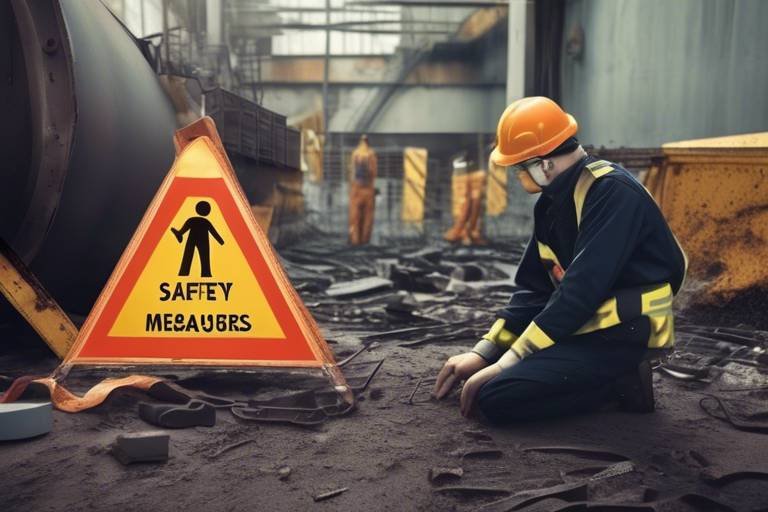Establishing Safety Standards through Human Behavior Analysis
In today's fast-paced world, the importance of safety cannot be overstated. Whether it's in construction sites, healthcare facilities, or corporate offices, the need for robust safety standards is paramount. But what if I told you that the key to enhancing these standards lies not just in regulations or equipment but in the very essence of human behavior? Yes, you heard it right! By analyzing how people act and react in various situations, organizations can forge a safer environment for everyone involved. This article delves into the fascinating intersection of human behavior and safety standards, exploring how psychological insights can be woven into the fabric of safety protocols and training programs.
Understanding human behavior is crucial for developing effective safety standards. Think about it: every safety protocol is ultimately designed to influence how individuals behave. If we can decode the motivations and reactions behind people's actions, we can create a more effective safety culture. For instance, consider a factory where workers are required to wear helmets. If the employees perceive this as a mere formality, they might neglect it. However, if they understand the real risks and the reasons behind the rule, they are more likely to comply. Hence, behavioral analysis is not just an academic exercise; it is a practical tool that can lead to significant safety improvements.
So, how do we analyze human behavior in safety contexts? Various techniques are employed to gather insights that can inform safety improvements. These include:
- Observational Studies: Directly observing how individuals behave in their work environment can yield invaluable data.
- Surveys and Questionnaires: These tools help in understanding perceptions and attitudes towards safety protocols.
- Data Analytics: By analyzing existing data, organizations can uncover patterns that may not be immediately visible.
Each of these methods has its strengths and can be tailored to fit the specific needs of an organization. Let’s take a closer look at some of these techniques.
Observational studies provide valuable insights into real-world behavior. Imagine walking through a busy warehouse and noticing how employees interact with machinery or safety equipment. Direct observation can highlight unsafe practices that might otherwise go unnoticed. For example, if a worker consistently bypasses a safety guard on a machine, this behavior can be documented and addressed through targeted interventions. By understanding the context and motivations behind such actions, organizations can develop strategies that resonate better with their workforce.
Real-world case studies demonstrate the effectiveness of observational studies. In the construction industry, for instance, a company implemented a program where safety managers observed workers on-site. They identified common risky behaviors, such as improper ladder use, and tailored training sessions to address these specific issues. As a result, the organization saw a significant drop in accidents. This approach not only improved safety practices but also fostered a culture of accountability among workers.
While observational studies are beneficial, they are not without limitations. Potential biases can creep in, affecting the reliability of findings. For example, if observers are aware that they are being watched, workers might alter their behavior, leading to skewed data. Additionally, the context of observations can vary widely, making it challenging to draw universal conclusions. Therefore, it's essential to combine observational data with other methods for a more comprehensive understanding of behavior.
Surveys and questionnaires are essential tools for gathering data on safety perceptions and behaviors. By designing these tools thoughtfully, organizations can extract actionable insights that lead to safety improvements. For instance, asking employees about their views on existing safety protocols can uncover gaps in understanding or compliance. Moreover, open-ended questions can provide qualitative data that sheds light on the underlying reasons for certain behaviors. This information is invaluable for crafting targeted safety initiatives.
Incorporating behavioral insights into safety training programs is vital. Traditional training often focuses solely on procedures and regulations, but by addressing human behavior, organizations can foster a deeper understanding of safety. For example, training sessions that include discussions about real-life incidents and the human factors involved can resonate more with employees. This approach not only enhances learning but also promotes a culture of safety where everyone feels responsible for maintaining standards.
Role-playing and simulations are effective methods for training individuals in safety protocols. These techniques allow employees to engage in scenarios that mimic real-life situations, helping them to understand the consequences of their actions. For instance, a simulation involving a fire drill can illustrate the importance of following evacuation procedures. By experiencing these situations in a controlled environment, employees are more likely to retain the information and apply it in real emergencies.
Establishing feedback mechanisms allows organizations to continuously improve safety standards. Gathering employee feedback is crucial for refining training and safety protocols based on real experiences. For instance, implementing regular safety meetings where employees can voice their concerns and suggestions can lead to significant improvements. This two-way communication fosters a sense of ownership and encourages a proactive approach to safety.
Q: Why is human behavior analysis important for safety standards?
A: Human behavior analysis helps organizations understand how individuals interact with safety protocols, leading to more effective training and improved compliance.
Q: What are the limitations of observational studies?
A: Observational studies can be biased due to the presence of observers and may not capture the full context of behaviors.
Q: How can feedback mechanisms improve safety standards?
A: Feedback mechanisms allow employees to share their experiences and suggestions, helping organizations refine their safety protocols based on real insights.

The Importance of Human Behavior in Safety
Understanding human behavior is not just a nice-to-have in the realm of safety; it’s a fundamental necessity. When we think about safety standards, we often focus on equipment, protocols, and regulations. However, the reality is that human actions—whether intentional or accidental—play a pivotal role in determining safety outcomes. Imagine a workplace where all safety gear is available, yet employees consistently ignore safety protocols. This scenario underlines the fact that behavior drives safety.
So, why is analyzing behavior so critical? Well, behaviors influence safety outcomes in several ways. For instance, if employees do not understand the importance of wearing safety equipment, they are less likely to use it. Additionally, a culture that promotes safety can significantly reduce incidents. To foster this culture, we must first analyze and understand the behaviors that either contribute to or detract from safety.
The need for behavioral analysis in safety protocols cannot be overstated. By examining how individuals behave in various situations, organizations can identify patterns that lead to unsafe practices. For example, if a particular task is frequently performed without proper safety measures, it may indicate a gap in training or awareness. By addressing these gaps, organizations can implement targeted interventions that not only enhance safety but also improve overall productivity.
To illustrate the importance of human behavior in safety, consider the following key points:
- Behavioral Influence: The choices individuals make directly impact their safety and that of their colleagues.
- Culture of Safety: A positive safety culture encourages employees to prioritize safety in their daily tasks.
- Training Gaps: Identifying behavioral trends can reveal weaknesses in training programs that need to be addressed.
In summary, human behavior is at the heart of safety standards. By delving into the psychology behind actions, organizations can create more effective safety protocols that not only comply with regulations but also resonate with employees on a personal level. After all, when people understand the "why" behind safety measures, they are far more likely to embrace them. This understanding can lead to a safer, more productive environment for everyone involved.

Behavioral Analysis Techniques
When it comes to enhancing safety standards, play a pivotal role. These techniques are not just about observing what people do; they delve into the intricacies of why they do it. Understanding the motivations and thought processes behind human actions can provide invaluable insights that lead to improved safety protocols. By employing a variety of methods, organizations can uncover patterns that may not be apparent at first glance. Let's explore some of the key techniques used in behavioral analysis.
One of the most effective methods is observational studies. This technique involves watching individuals in their natural work environments to identify unsafe practices or behaviors that could lead to accidents. For instance, a safety analyst might observe a construction site to see how workers handle heavy machinery. By documenting these behaviors, analysts can pinpoint specific actions that pose risks and develop targeted interventions to mitigate them. However, it’s essential to approach observational studies with a clear plan to minimize biases and ensure that the data collected is reliable.
Another valuable technique is the use of surveys and questionnaires. These tools allow organizations to gather data on employees’ perceptions of safety and their own behaviors. By designing surveys that ask specific questions about safety practices, organizations can gain insights into how employees view their work environment. For example, questions might include:
- How often do you feel safe while performing your job?
- Have you ever witnessed unsafe practices in your workplace?
- What safety training have you received, and how effective do you believe it is?
The responses to these questions can reveal trends and areas where additional training or resources may be needed. Additionally, data analytics plays a significant role in behavioral analysis. By analyzing large datasets, organizations can identify patterns in incidents and near-misses, leading to a deeper understanding of the factors contributing to unsafe behaviors.
In summary, the integration of various behavioral analysis techniques is essential for developing effective safety standards. By observing behaviors, gathering feedback through surveys, and utilizing data analytics, organizations can create a comprehensive approach to safety that not only addresses current issues but also anticipates future challenges. This proactive stance is crucial in fostering a culture of safety that prioritizes the well-being of every employee.

Observational Studies
Observational studies are a powerful tool in the realm of safety analysis, offering a window into the real-world behaviors that can lead to both accidents and safe practices. By directly observing individuals in their work environments, researchers can gather invaluable data that might be missed through other methods. This approach allows safety professionals to see firsthand how people interact with their surroundings, the tools they use, and the protocols they follow—or ignore. Imagine trying to fix a complex machine without actually seeing how it operates; that’s what traditional safety protocols can feel like without the insights gained from observational studies.
One of the key advantages of observational studies is their ability to capture the nuances of human behavior in situ. For instance, a safety analyst might observe a construction site where workers are expected to wear helmets. Through direct observation, they might notice that while most employees comply, a few consistently neglect this safety measure. This insight can lead to targeted interventions, such as additional training or reminders, tailored specifically to those individuals. The goal is not just to enforce rules but to understand the *why* behind behaviors, paving the way for more effective safety practices.
However, while observational studies provide rich qualitative data, they are not without their challenges. Factors such as observer bias can influence the outcomes of these studies. For example, if an observer has a preconceived notion about what constitutes safe behavior, they might overlook certain unsafe practices or misinterpret actions. To mitigate this, employing multiple observers and using standardized checklists can help ensure that the data collected is as objective and reliable as possible. Below is a summary of the advantages and limitations of observational studies:
| Advantages | Limitations |
|---|---|
| Provides real-time insights into behaviors | Potential for observer bias |
| Can identify unsafe practices directly | Time-consuming and resource-intensive |
| Enables targeted interventions | Limited to observable behaviors |
Incorporating observational studies into safety protocols not only enhances understanding but also fosters a culture of safety within organizations. When employees see that their behaviors are being observed and analyzed, it encourages them to be more mindful of their actions. This heightened awareness can lead to a collective effort in promoting safety, as individuals become more conscious of their own practices and those of their colleagues. In essence, observational studies act as a mirror, reflecting the reality of workplace behaviors and providing a foundation for continuous improvement in safety standards.

Case Studies in Industries
When it comes to enhancing safety standards through human behavior analysis, real-world examples speak volumes. Various industries have successfully implemented behavioral insights to bolster safety practices, showcasing the tangible benefits of this approach. For instance, in the construction sector, a major company undertook a comprehensive observational study to identify unsafe practices on job sites. By closely monitoring workers, they discovered that distractions, such as mobile phone usage, were a significant contributor to accidents. This insight led to the implementation of strict policies regarding phone usage and the introduction of regular safety briefings that emphasized the importance of focus on the job at hand.
Another compelling case can be found in the healthcare industry. A hospital recognized that many of its staff were not following proper hand hygiene protocols, which posed a risk to patient safety. By utilizing surveys and observational methods, the hospital identified that the primary reasons for non-compliance were time constraints and a lack of awareness about the potential consequences. In response, they developed a targeted training program that included role-playing scenarios and simulations, allowing staff to practice proper techniques in a safe environment. The result? A remarkable increase in compliance rates, leading to a significant reduction in hospital-acquired infections.
Moreover, the aviation industry has also made strides in safety through behavioral analysis. Airlines have employed data analytics to assess pilot behavior during training simulations. By analyzing patterns in decision-making and communication, airlines were able to identify areas where pilots could improve their situational awareness. This led to the creation of tailored training modules that focused on enhancing these critical skills. As a result, there was a noticeable decrease in incidents related to miscommunication and poor judgment during flights.
These examples illustrate the profound impact that behavioral insights can have on safety practices across various sectors. The integration of observational studies, surveys, and data analytics not only helps identify unsafe behaviors but also fosters a culture of safety that encourages continuous improvement. As industries continue to recognize the importance of human behavior in safety, we can expect to see even more innovative approaches to enhancing safety standards.

Limitations of Observational Studies
While observational studies are a powerful tool for understanding human behavior in safety contexts, they are not without their limitations. One of the primary challenges is the potential for observer bias. This occurs when the person conducting the observation allows their personal beliefs or expectations to influence their interpretation of the data. For example, if an observer has preconceived notions about what constitutes unsafe behavior, they might overlook actions that contradict their beliefs, leading to skewed results.
Another significant limitation is the Hawthorne effect, where individuals alter their behavior simply because they know they are being observed. This phenomenon can result in data that does not accurately reflect typical behavior, as people may act more cautiously or follow safety protocols more strictly than they normally would. Consequently, the insights gained from such observations may not translate effectively into real-world scenarios.
Furthermore, observational studies often require a considerable amount of time and resources to gather sufficient data. The need for prolonged observation can lead to logistical challenges, especially in fast-paced environments where conditions change rapidly. This can result in gaps in data collection, which may hinder the ability to draw comprehensive conclusions.
In some cases, the sample size of observational studies may be limited, particularly in niche industries or specialized environments. A small sample size can affect the reliability and generalizability of the findings, making it difficult to apply the results to a broader context. For instance, if only a handful of workers are observed, the behaviors noted may not represent the entire workforce, leading to incomplete or misleading safety insights.
Finally, while observational studies provide valuable qualitative data, they often lack quantitative metrics that can be essential for evaluating safety performance. Without numerical data to support findings, organizations may struggle to implement effective changes based on observational insights alone.
- What are observational studies? Observational studies involve watching and recording behaviors in real-world settings to understand how individuals act in relation to safety protocols.
- How can observer bias affect safety analysis? Observer bias can lead to misinterpretation of behaviors, resulting in inaccurate conclusions about safety practices and potential risks.
- What is the Hawthorne effect? The Hawthorne effect describes how individuals may change their behavior when they know they are being observed, which can skew the results of observational studies.
- Are observational studies time-consuming? Yes, observational studies often require significant time and resources to gather meaningful data, which can pose challenges in fast-paced work environments.

Surveys and Questionnaires
Surveys and questionnaires serve as essential tools for gathering insights into safety perceptions and behaviors within various industries. By collecting data directly from employees, organizations can gain a clearer understanding of the human factors that influence safety outcomes. This process is not just about ticking boxes; it's about diving deep into the psyche of the workforce to uncover the underlying attitudes that drive behavior. After all, if we want to improve safety, we must first understand what employees think and feel about their work environment.
When designing surveys and questionnaires for safety analysis, it's crucial to ask the right questions. This means creating a balance between quantitative and qualitative inquiries. For instance, while numerical ratings can provide measurable data, open-ended questions allow employees to express their thoughts in their own words. This combination can yield actionable insights that are often missed when relying solely on one type of question. Here are some examples of effective questions to include:
- On a scale of 1-10, how safe do you feel in your work environment?
- What safety concerns do you believe are not being addressed?
- Can you describe a time when you felt unsafe at work?
Moreover, it’s vital to ensure that these tools are designed to promote honesty and anonymity. Employees are more likely to provide genuine feedback when they know their responses won’t be traced back to them. This is where online platforms often come in handy, allowing for anonymous submissions that can lead to more candid responses. The data collected can then be analyzed to identify trends and patterns that highlight areas needing improvement.
Another key aspect of surveys and questionnaires is the timing of their administration. Conducting these assessments at strategic intervals—such as after training sessions or following significant safety incidents—can yield insights into the effectiveness of safety protocols and training programs. For example, a survey conducted after a new safety training program can help determine whether employees feel more equipped to handle potential hazards.
Once the data is collected, organizations can utilize various analytical tools to interpret the findings. This could involve statistical analysis to quantify safety perceptions or thematic analysis to identify common themes in qualitative responses. The goal is to translate this data into meaningful actions that enhance workplace safety. For instance, if a significant number of employees express concerns about a particular safety procedure, it may be time to reassess and revise that protocol.
In conclusion, surveys and questionnaires are not merely administrative tasks; they are powerful instruments in the quest for improved safety standards. By prioritizing employee feedback, organizations can foster a culture of safety that not only protects workers but also enhances overall productivity and morale. After all, when employees feel heard and valued, they are more likely to engage actively in safety practices, leading to a safer workplace for everyone.
Q1: How often should surveys and questionnaires be conducted?
A1: It is recommended to conduct surveys at least once a year, but more frequent assessments may be beneficial, especially after significant changes in safety protocols or following incidents.
Q2: What types of questions should be included in safety surveys?
A2: Include a mix of quantitative questions (e.g., rating scales) and qualitative questions (e.g., open-ended responses) to gather comprehensive insights into employee safety perceptions.
Q3: How can organizations ensure anonymity in surveys?
A3: Utilize online survey tools that allow for anonymous submissions and communicate clearly to employees that their responses will remain confidential.

Integrating Behavioral Insights into Training
In today's fast-paced work environment, integrating behavioral insights into safety training programs is not just beneficial; it's essential. When organizations understand that human behavior plays a pivotal role in safety outcomes, they can create training that truly resonates with employees. This approach goes beyond the traditional methods of simply relaying rules and regulations; it focuses on fostering a deep-rooted culture of safety that empowers individuals.
One of the most effective strategies for integrating these insights is to design training sessions that are not only informative but also engaging. Imagine a training program where employees are not just passive listeners but active participants. By incorporating elements such as role-playing and simulations, organizations can create realistic scenarios that mimic potential hazards in the workplace. This hands-on experience helps learners to internalize safety protocols, making them more likely to remember and apply what they’ve learned when faced with real-life situations.
Moreover, feedback mechanisms play a crucial role in refining safety training. By establishing channels through which employees can share their experiences and insights, organizations can continuously improve their training programs. For instance, after a training session, employees could be asked to provide feedback on what they found most useful or what areas they struggled with. This information can then be analyzed to adjust future training sessions, ensuring they remain relevant and effective.
Another important aspect of integrating behavioral insights is the recognition of different learning styles among employees. Not everyone absorbs information in the same way. Some may prefer visual aids, while others might benefit from auditory or kinesthetic learning. By diversifying training materials and methods—such as incorporating videos, interactive workshops, and hands-on exercises—organizations can cater to a wider audience, enhancing the overall effectiveness of their safety training.
In summary, integrating behavioral insights into safety training is about more than just compliance; it's about building a culture where safety is a shared value. By creating engaging, responsive, and multifaceted training programs, organizations can empower their employees, reduce risks, and ultimately enhance safety standards across the board. The journey toward a safer workplace begins with understanding and addressing the human element in safety protocols.
- Why is it important to integrate behavioral insights into safety training?
Integrating behavioral insights helps tailor training to the actual behaviors and perceptions of employees, making it more effective and relevant. - What are some effective methods for incorporating behavioral insights?
Methods such as role-playing, simulations, and feedback mechanisms are effective in making training engaging and practical. - How can organizations gather feedback from employees?
Organizations can use surveys, suggestion boxes, or direct discussions to gather valuable feedback from employees about safety training.

Role-Playing and Simulations
When it comes to safety training, role-playing and simulations are not just buzzwords; they are powerful tools that can transform the way individuals learn and internalize safety protocols. Imagine stepping into a scenario where you have to react to an emergency situation in real-time. This immersive experience is what role-playing offers, allowing participants to practice their responses in a controlled environment. The beauty of these methods lies in their ability to bridge the gap between theoretical knowledge and practical application, making safety training not only more engaging but also more effective.
In a typical role-playing session, participants are assigned specific roles and are placed in a scenario that mimics real-life situations they may encounter in their workplace. For instance, in a manufacturing plant, employees might engage in a simulation of a machinery malfunction. This hands-on approach not only helps individuals understand the protocols they need to follow but also builds confidence in their ability to act decisively under pressure. As they navigate through the scenario, they can experiment with different responses and learn from their mistakes, all while receiving immediate feedback from trainers and peers.
Furthermore, simulations can incorporate advanced technology, such as virtual reality (VR), to create an even more immersive experience. With VR, employees can face lifelike situations without the risk of actual harm. This technology allows them to practice safety measures in a safe space, enhancing their learning experience. According to research, participants in VR simulations demonstrated a 30% increase in safety knowledge retention compared to traditional training methods. This statistic alone highlights the effectiveness of incorporating modern technology into safety training.
Moreover, the collaborative nature of role-playing and simulations fosters a culture of safety within organizations. When employees engage in these activities together, they build camaraderie and learn from one another. This shared experience can lead to improved communication and teamwork in real-life situations, which is crucial during emergencies. The more comfortable individuals feel with their colleagues, the more likely they are to speak up about unsafe practices or suggest improvements, creating a proactive safety environment.
To maximize the effectiveness of role-playing and simulations, organizations should consider the following key elements:
- Realism: Scenarios should closely mimic actual workplace situations to ensure relevance.
- Debriefing: After each session, a thorough discussion should take place to analyze actions and decisions made during the simulation.
- Customization: Tailor scenarios to fit the specific needs and risks associated with the organization’s industry.
In conclusion, role-playing and simulations are invaluable tools in the realm of safety training. By providing a hands-on, engaging, and realistic approach, they not only enhance understanding and retention of safety practices but also cultivate a culture of safety that empowers employees to take ownership of their safety and that of their colleagues. As we continue to evolve and adapt to new challenges in the workplace, these innovative training methods will undoubtedly play a pivotal role in shaping safer environments for all.
Q1: How often should role-playing and simulations be conducted in safety training?
It is recommended to incorporate these methods regularly, ideally at least once a quarter, to keep safety protocols fresh and relevant for employees.
Q2: Can role-playing be effective for remote teams?
Absolutely! With the help of video conferencing tools, remote teams can engage in role-playing scenarios, ensuring that all employees, regardless of location, receive the same level of training.
Q3: What types of scenarios are most effective for role-playing?
Scenarios that are directly related to the specific risks and challenges of the workplace are the most effective. Tailoring scenarios to fit the organization’s unique environment is crucial for maximizing impact.

Feedback Mechanisms
Establishing is a game changer when it comes to enhancing safety standards within organizations. Imagine a workplace where employees feel empowered to voice their concerns and share their experiences regarding safety protocols. This open line of communication not only fosters a culture of trust but also leads to actionable insights that can significantly improve safety practices. By regularly collecting feedback from employees, organizations can identify potential hazards, understand the effectiveness of training programs, and make informed decisions that prioritize the well-being of their workforce.
Feedback mechanisms can take various forms, each designed to suit the unique needs of an organization. For instance, organizations might implement regular safety meetings, anonymous suggestion boxes, or digital platforms where employees can report safety concerns. Each of these methods has its own advantages, but the key is to create an environment where employees feel comfortable sharing their thoughts without fear of repercussions. This kind of atmosphere encourages honesty and can reveal underlying issues that may not be apparent through formal assessments alone.
Moreover, feedback loops are essential for continuous improvement. After gathering feedback, it’s crucial to analyze the data and take action based on the findings. This could involve revising safety protocols, enhancing training programs, or even recognizing employees who contribute valuable insights. By demonstrating that feedback is taken seriously and leads to tangible changes, organizations can motivate employees to engage in the process actively. It’s like planting a seed; with the right care and attention, it can grow into something robust and beneficial for everyone involved.
To illustrate the importance of feedback mechanisms, consider the following table that outlines various feedback methods and their benefits:
| Feedback Method | Benefits |
|---|---|
| Safety Meetings | Encourages open dialogue, fosters teamwork, and identifies immediate concerns. |
| Anonymous Suggestion Boxes | Allows for honest feedback without fear of repercussions, encourages candidness. |
| Digital Reporting Platforms | Facilitates quick reporting of safety issues and can track trends over time. |
Incorporating feedback mechanisms into safety protocols not only enhances safety standards but also cultivates a proactive safety culture. Employees become more vigilant and engaged when they feel their input is valued. This transformation can lead to a significant reduction in accidents and incidents, as workers are more likely to report unsafe conditions and suggest improvements. It’s a win-win situation: the organization benefits from improved safety practices, and employees feel a sense of ownership and responsibility towards their workplace.
In conclusion, establishing effective feedback mechanisms is not just a procedural step; it is a vital component of a successful safety strategy. By actively seeking and acting on employee feedback, organizations can create a safer, more productive environment that ultimately leads to enhanced overall performance. So, why not start today? Encourage your team to share their thoughts and watch as your safety standards soar!
- What are feedback mechanisms? Feedback mechanisms are processes through which organizations gather input from employees regarding safety practices, concerns, and suggestions for improvement.
- Why are feedback mechanisms important for safety? They help identify potential hazards, assess the effectiveness of training, and foster a culture of trust and engagement among employees.
- How can organizations implement feedback mechanisms? Organizations can use various methods such as safety meetings, anonymous suggestion boxes, and digital reporting platforms to encourage employee feedback.
- What should be done with the feedback collected? Feedback should be analyzed and acted upon, leading to revisions in safety protocols, training enhancements, and recognition of employee contributions.
Frequently Asked Questions
- Why is understanding human behavior important for safety standards?
Understanding human behavior is crucial because it directly influences how individuals respond to safety protocols. By analyzing behaviors, organizations can identify risky practices and develop strategies that align with how people naturally act, making safety measures more effective and easier to adopt.
- What are some common behavioral analysis techniques used in safety?
Common techniques include observational studies, surveys, and data analytics. Observational studies allow for real-time insights into behaviors, surveys gather perceptions and self-reported practices, while data analytics can reveal patterns and trends that inform safety improvements.
- How do observational studies contribute to safety improvements?
Observational studies provide a direct look at how people behave in real-world situations. By identifying unsafe practices through observation, organizations can implement targeted interventions to correct these behaviors, ultimately leading to enhanced safety outcomes.
- What are the limitations of observational studies?
While observational studies are valuable, they can be subject to biases, such as observer bias or the Hawthorne effect, where individuals change their behavior because they know they are being observed. These factors can affect the reliability of the findings and should be considered when interpreting results.
- How can surveys and questionnaires improve safety protocols?
Surveys and questionnaires can collect data on employees' perceptions of safety and their behaviors. By designing these tools effectively, organizations can gain actionable insights that highlight areas needing improvement, allowing for more tailored safety protocols and training programs.
- What role do simulations play in safety training?
Simulations and role-playing are effective training methods because they provide hands-on experience in a controlled environment. This approach helps individuals better understand safety protocols and enhances retention, making it more likely that they will apply what they've learned in real-life situations.
- Why is feedback important in safety training?
Feedback mechanisms are essential for continuous improvement. By gathering input from employees about their training experiences and safety practices, organizations can refine their protocols and training programs, ensuring they remain relevant and effective in promoting a culture of safety.



















